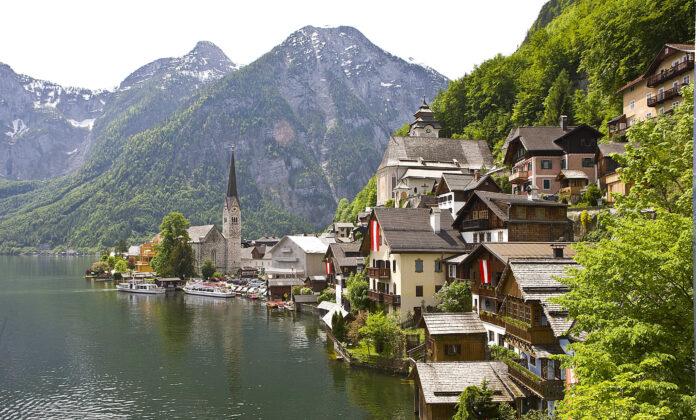Vacationers are drawn to Austria all year long since it is one of the most popular holiday destinations in Europe and because there are places to visit in both the summer and the winter. In point of fact, since this country is home to some of the greatest snowboarding in Europe, the winter months in this country’s breathtaking mountain regions are almost as busy as the summer months.
Guests are attracted to this Alpine republic not only for the splendor of its towns, such as Vienna (Wien), the country’s historic capital, and lovely Salzburg, where Wolfgang Amadeus Mozart was born, but also for the picturesque beauty of the provinces that make up the country.
The Austrian Alps take up around 60% of the country’s total geographical area, making Austria one of the smallest countries in Europe. The Austrian Alps make up the majority of the terrain in Austria, which is mostly made up of highlands and mountains. It is estimated that the Danube River runs about 350 kilometers from west to east across the northern half of the country, adding to the country’s appeal as a tourist destination.
Using this guide to Austria’s most popular tourist destinations, you can plan your trip to include the most memorable activities and places to see during your time there.
1. The Hofburg in Vienna is known as the Imperial Palace of Austria.
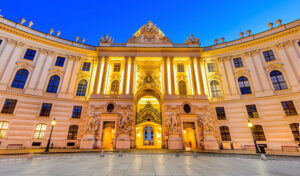
The magnificent Hofburg Palace in Vienna served the powerful Habsburg dynasty as their official residence for hundreds of years throughout their reign as monarchs of Austria. It is highly recommended that you pay a visit to this palace while you are in Austria.
Now, the President of the United States conducts official business in the same rooms that once belonged to Emperor Joseph II. Virtually every Austrian ruler since 1275 has ordered additions or alterations, which has resulted in many different architectural influences, including Gothic, Renaissance, Baroque, Rococo, and Classicism.
The whole Hofburg complex is on a land area of around 59 acres and is comprised of 19 courtyards and over 2,600 rooms. This is in addition to the several charming squares and gardens that the complex has. The royal Silver Collection and the several dining establishments that provide a taste of the sumptuous royal dinners that formerly took place here are two of the highlights of a trip here.
Both the Sisi Museum, which focuses on the lives and events that occurred during the reign of Empress Elisabeth, and the Imperial Flats, which are a collection of 19 apartments that were formerly inhabited by Emperor Franz Joseph and his spouse, are other worthwhile places to visit.
Michaelerkuppel, 1010 Vienna is the address to use.
2. The Salzburg Altstadt, which is included on the UNESCO World Heritage List
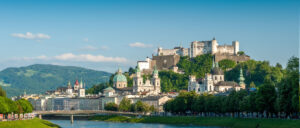
From the early days of Christianity in Europe, Salzburg served as a religious center due to the fact that it was the seat of Prince Archbishops. In the year 690 A.D., Saint Rupert established the Benedictine Abbey of St. Peter, which later became the official house of the Archbishops of the city until the early 1100s. The abbey is located in the middle of the Altstadt, often known as the Old City.
In order to construct and improve their churches, residences, and monasteries, the Prince Archbishops hired some of the most talented artists and designers of their time. Despite the fact that these structures were “modernized” to conform to the aesthetic preferences of succeeding centuries, the combination of medieval and Baroque architecture has resulted in the creation of a fascinating historical district that can be explored.
The highlights include St. Peter’s Abbey and its cathedral, as well as the picturesque cemetery and its catacombs, which are instantly recognized as a shooting location for The Sound of Music.
The cathedral is located in the neighborhood, and if you roam about the colorful Baroque burgher residences, you can stumble onto several attractive squares and areas of interest, including the birthplace of Wolfgang Amadeus Mozart, which has been converted into a museum. Funiculars will take you up to the top of Salzburg’s Hohensalzburg fortress, which towers majestically over the city’s picturesque spires and cupolas.
Salzburg’s Best Places to Stay, Including Both Hotels and Other Lodging Options
3. Austria’s Spanish Driving School, located in Vienna
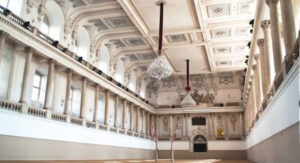
The origins of the Spanish Driving School may be traced back to the reign of Emperor Maximilian II, who is most remembered for being the one who brought the world-famous Lipizzaner horses to Austria in the year 1562.
At the time, it is one of the few remaining places on the planet where the traditional manner of etiquette that was traditionally followed by aristocrats is still followed. One of the best things to do in Vienna is to take in one of the well-known equestrian displays that are put on at the Baroque Winter Driving Faculty. These shows have been going on in this location ever since the reign of Charles VI.
The splendid hallway, which was constructed in 1735, was intended to provide a venue for members of the aristocracy to demonstrate their ability with various implements. Tickets to see these gorgeous creatures perform their dance are widely sought after, so make sure to make your reservation online as long in advance as you possibly can.
Michaelerplatz 1, 1010 Vienna is the address to use.
4. Palace of Schonbrunn in Vienna, Austria
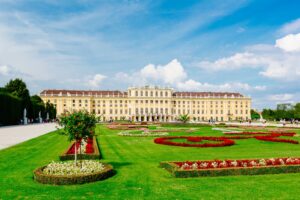
The Baroque Schonbrunn Palace, which is located on the outskirts of Vienna, was finished in the early 1700s and subsequently turned into a summer house by Empress Maria Theresa. The palace is known for its opulent interiors and lavish furnishings.
The Royal Apartments, the Nice Gallery with its exquisite ceiling work, the Million Room, and Maria Theresa’s salon with its carved and gilded rosewood panels are some of the highlights of a walk of the 40 rooms of the palace that are available to the general public. Other rooms of the palace that are open to the public include the Throne Room and the Orangery. In addition, you will have the opportunity to take in the breathtaking Corridor of Mirrors, which is adorned with gold Rococo-framed mirrors. The palace has 1,441 rooms, and it is surrounded by 500 acres of parks and gardens that are all designed in the Baroque style of the 18th century.
When you go to Schonbrunn, you should make time to see all of the various attractions that are dispersed throughout these grounds. These include formal gardens, a labyrinth, the Palm House, which is filled with exotic and unique plants and butterflies, an Alpine garden with a farmhouse, Europe’s oldest zoo, and the Classical Gloriette, a grand marble structure that crowns a hill above the gardens.
The building that once housed the Winter Driving School is now home to a carriage museum that features hundreds of classic state coaches and sleighs. Your whole palace in addition to its expansive grounds has been designated as a UNESCO World Heritage Site.
Schonbrunner Schloßstraße 47, 1130 Vienna is the address to use.
5. The Hofburg and the Hofkirche in Innsbruck

Innsbruck was elevated to the status of principal home and seat of Hapsburg authority during the reign of Emperor Maximilian I, who ruled through the latter half of the 1500s and the early 1600s. As a result, the city became a focal point in Europe. Maria Theresa, who ruled Austria throughout the 18th century, is responsible for the Baroque and Rococo renovations that were made to his castle, the Hofburg. The opportunity to witness the magnificent royal apartments, the marble Great Corridor (Riesensaal), and the painted ceilings across the whole building are some of the highlights of a visit.
The magnificent Tomb of Emperor Maximilian I, who passed away in 1519, is the attraction par excellence of the Hofkirche, also known as the Court Church. The massive sarcophagus made of black marble and adorned with a bronze figure of the Emperor is the monument’s defining feature, and it is often regarded as the finest piece of German Renaissance sculpture ever created. The tomb is surrounded by 28 larger-than-life-size bronze sculptures representing the Emperor’s ancestors and contemporaries (keep an eye out for King Arthur), and the borders of the sarcophagus are adorned with 24 marble reliefs illustrating events from the Emperor’s life. King Arthur is one of the figures featured.
Other works of sculpture include twenty-three bronze sculptures of saints that belonged to the Habsburg family and twenty bronze busts of Roman emperors. All of these pieces were cast in bronze.
Rennweg 1/3, 6020 Innsbruck is the address for the tackle.
Find Out More About the Most Popular Tourist Attractions in and Around Innsbruck, as well as Easy Day Trips
6. The Benedictine Abbey of Melk

Melk Abbey is one of the most well-known monastic sites in the world, and its outstanding structures are arranged around seven different courtyards. The west end of this massive, 325-meter-long complex, with its twin-towered church towering above a semicircular terrace range, is perhaps the most notable portion of the complex.
The abbey, which is located on a rocky outcrop high above the city of Melk and overlooking the Danube, has quite a few more wonderful reasons to spend a few hours exploring it in addition to its stunning location. These include the burial of Saint Coloman of Stockerau, the residence of Austria’s first royal family, the Home of Babenberg, and the magnificent 196-meter-long Imperial Hall with its paintings of Austria’s emperors, including many depictions of Empress Maria Theresa.
You may also have a look at the Imperial Rooms, which are located next to the main entrance and include displays on the abbey’s history. These displays include sculptures and other works of art.
Abt-Berthold-Dietmayr-Straße 1, 3390 Melk is the address to send mail to.
Find Out More About the Most Popular Tourist Attractions in Melk
7. The Salzkammergut, including Hallstatt and the Dachstein
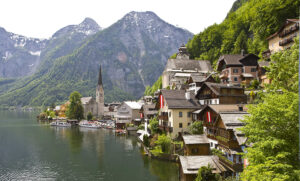
Without a shadow of a doubt, Hallstatt is without a doubt one of the most gorgeous little towns in Austria, if not all of Europe. In addition, it is a good starting point for exploring the breathtaking Dachstein Salzkammergut region, which is included on the UNESCO World Heritage list.
Hallstatt’s prosperity, which dates back to ancient times and is based on the town’s extensive history of salt production, is attested to by the lovely Baroque architecture that can be seen there.
You may also travel to the subterranean salt lake that is located inside the nearby Hornerwerk cavern, or you can explore the Dachstein Caves, which are one of the most beautiful cave networks in Europe and include areas that are as deep as 1,174 meters. Both of these options are available. The Big Ice Cave, with its subzero summertime temperatures and enormous caverns with gorgeous frozen waterfalls, and the Mammoth Cave, with its large pipe-shaped tunnels fashioned by a historical subterranean river, are two of the cave system’s most popular attractions. Both caves include stunning frozen waterfalls.
The 5 Fingers observation platform is an inconceivable metal building that hangs over a steep drop of 400 meters and provides visitors with amazing views of the surrounding Alps. Guests may access this platform from the level above.
Find Out More About the Most Popular Tourist Attractions in Hallstatt and Alongside the Hallstatter See in Austria
8. Kitzbuhel and the Kitzbuheler Horn are both great locations for snowboarding.
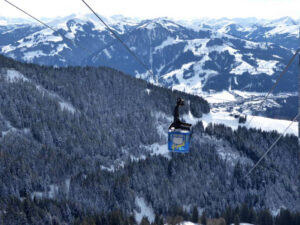
Kitzbuhel, a well-known resort town in Austria, is widely regarded as one of the best places in the country to go skiing. The town has 170 kilometers of skiable pistes and slopes that are littered with little mountain huts where skiers and snowboarders may stop for traditional Alpine refreshments and snacks.
In spite of the fact that it hosts the annual Hahnenkamm, the most difficult of all downhill ski races, Kitzbuhel’s three snowboarding areas provide a wide variety of terrain suitable for riders of all skill levels. The Bichlalm area, the smallest of the three, is specifically designed for freeriders.
However, skiers aren’t the only ones who can enjoy Kitzbuhel. The city is as picture-perfect as it is possible for an Alpine community to be, what with its frescoed walls and residences with the snow-capped Alps as a background.
The 1,998-meter Kitzbuheler Horn is a favorite for mountain hikers in the summer, and you can also reach the peak by cable car through the Pletzeralm. In the winter, skiers enjoy the Kitzbuheler Horn, while mountain hikers enjoy it in the summer. It is considered to have one of the greatest summit views in all of Tyrol, with a panorama that stretches to the south from the Radstadter Tauern all the way to the Otztal Alps, to the north from the nearby Kaisergebirge, to the west from the Lechtal Alps, and to the east from the Hochkonig.
The 1,772-meter-high Hornkopfli, which may also be accessed by cableway, can be found to the south of the Kitzbuheler Horn. In addition to the breathtaking scenery, the peak is home to a number of interesting buildings, including an Alpine garden, a church, a restaurant, and a mountaintop home known as the Gipfelhaus.
Find Out More About the Most Popular Tourist Attractions in Kitzbuhel and Easy Day Trips Here!
9. Palace of the Belvedere in Vienna

The magnificent Belvedere Palace (also known as Schloss Belvedere) is another one of Austria’s most popular palaces, and it is definitely one that should be included in your trip plan for Vienna. You can find it in the city of Vienna. This significant historic landmark is often referred to as just “The Belvedere,” and it is really divided into two primary portions, which are known respectively as the Higher (Oberes) and Decrease (Unteres) Palaces.
In the event that you only have time to explore one, make it the Higher Palace. You’ll be able to see the most impressive piece of the attraction’s amazing collection of artworks right here, in addition to having the opportunity to look at one of the finest architectural treasures that has been conserved in the country. The Sala Terrena, which is the main hallway, is noteworthy for its statues and stucco vaulted ceiling. Other highlights include the Carlone hallway, which has a ceiling fresco; the two-story Marble Corridor, which features a large number of sculptures and works of art; and the stunning Ceremonial Staircase.
The Decrease Palace is not any significantly less deserving of a visit than any other palace. The Marble Gallery, which is known for its collection of statues; the Grotesque Corridor, which is known for its many strange wall works; and a second Marble Corridor, which is known for its unique ceiling fresco, are some of the highlights of the building.
The palace has an incredible café and restaurant, three shops, and an incredible Christmas Market for those who are traveling during the winter months. You must plan on spending the day here if you want to take advantage of everything the palace has to offer, so make sure you come prepared!
Prinz Eugen-Straße 27, 1030 Vienna is the address to use.
Discover More: An Insider’s Guide to the Belvedere Palace in Vienna: Information for Customers
10. Burg Hochosterwitz from the middle ages

The impressive Burg Hochosterwitz is Austria’s most important medieval fortification, and it is located to the east of St. Veit on a crag that rises about 160 meters above the valley floor. After a violent history, the castle was taken by the Khevenhullers, and in 1570, in the face of Turkish invasion, it was expanded in order to make it stronger. The earliest mention of the fortress was in the year 860 AD. Since it was never taken by an adversary, the fort has remained in the possession of the Khevenhuller family ever since.
The Burgweg, the steep entry street to the fort, winds its way up through the 14 defensive gates until it reaches the lovely arcaded courtyard. Here, you will find the small chapel with its wall and ceiling work from 1570 as well as the church on the southwestern end of the fort with its high altar relationship from 1729. Both of these structures were built during the same time period.
Hochosterwitz 1, 9314 Launsdorf is the tackle for this match.
11. The Franz-Josefs-Hohe Highway leading up to the Grossglockner Pass

Between 1930 and 1935, construction took place on the Grossglockner Hochalpenstrasse, which runs from Bruck, which is located in the Pinzgau, to Heiligenblut, which is located at the base of the Grossglockner. It is considered to be one of the most opulent and scenic mountain routes in all of Europe, and it follows the path of an old Roman roadway.
Even if its importance as a route over the Alps has decreased, it is still a spectacular road that passes through the Hohe Tauern, which is Austria’s tallest mountain massif and one of the country’s great areas of interest. The road travels through the mountains at an elevation of more than 2,000 meters over a distance of 22 kilometers, and it is comprised of a lengthy sequence of twists that leads up to the summit tunnel on the Hochtor at 2,506 meters, and then it descends into the valley on the other side of the mountain range.
The road provides access to the expansive Hohe Tauern mountain range, which is where Franz-Josefs-Hohe earned its reputation as one of the most beautiful locations in all of Europe. This magnificent vantage point is situated at an elevation of 2,422 meters above sea level and offers breathtaking views of the land that surrounds it. It was given its name in honor of a visit made by Emperor Franz-Josef in the year 1856. The Grossglockner, which stands at 3,798 meters in height and is Austria’s tallest peak, can be seen prominently in this panorama.
You won’t want to miss out on the in-depth displays about the world’s historical past that are on display at the visitor center. In addition, there are displays that focus on the world’s glaciers and general travel information.
Grossglockner’s official website may be found at www.grossglockner.at/gg/en/index.
12. Cathedral of St. Stephen in Vienna, Austria

Within the historic district of Vienna’s city center is where you’ll find the majestic Gothic cathedral of St. Stephen’s, also known as Stephansdom. The original Romanesque church, which was built in the twelfth century, was replaced in the thirteenth century by a Late Romanesque church; nonetheless, the large gate and the Heathen Towers (Heidenturme) still stand today.
The subsequent Gothic rebuilding, which took place in the 14th century, included the addition of the choir as well as the Chapels of St. Eligius, St. Tirna, and St. Catherine. The next century saw the erection of the well-known South Tower (Steffl), which stands 137 meters tall. The church was completely reconstructed after significant damage sustained during World War II.
There are 343 steps leading up to the Watch Room at the highest point of the Steffl, but there is an elevator that will take visitors to the observation platform on the North Tower, which is home to the enormous Pummerin Bell. The views from the Watch Room are well worth the effort. You won’t want to miss the catacombs, which date back to the 14th century, or the cathedral treasury, which is where some of the most important things in the cathedral are kept on display.
Stephansplatz 3, 1010 Vienna is the address to use.
Discover More: Investigating Vienna’s St. Stephen’s Cathedral in Austria
13. Both Klosterneuburg Abbey and the Verdun Altar may be found in Germany.
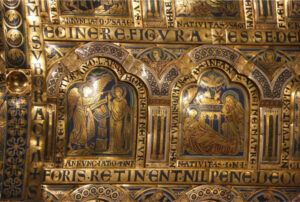
A winding staircase in the lovely Klosterneuburg Abbey goes all the way down to the St. Leopold’s Chapel, which was built in the twelfth century and is the location where King Leopold III is buried. at addition, it is possible to locate the well-known Verdun Altar at this location. The altar, which was made by Nicholas of Verdun and dates back to about 1181, is composed of fifty-one panels of champlevé work on gilded copper, each of which depicts a biblical event. The altar is considered to be the greatest existing example of medieval enamel work.
After a fire that occurred in 1329, the panels were moved from where they had been before, which was on the reading pulpit of the prior Romanesque church, and placed together to form the present winged altarpiece. The Abbey Museum is home to four painted panels that were originally placed to the altar in 1331. These panels have the distinction of being the oldest in Austria; they were painted in Vienna prior to the year 1329.
Stiftsplatz 1, 3400 Klosterneuburg is the address to use.
14. Cathedral of Saint Maria in Saal
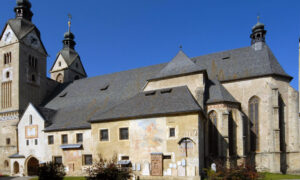
The Church of Maria Saal, which is more often referred to as the Maria Saal Cathedral, is located on a hill that is situated high above the Zollfeld and is one of the most important places of pilgrimage in the state of Carinthia, which is located in the southern region of Austria. Around the year 750 A.D., Bishop Modestus established a church at this location, and it was through this church that the area was eventually converted to Christianity.
On the site of a Roman basilica, the present church with its twin towers was first constructed in the Gothic architectural style during the first part of the fifteenth century. Subsequently, the church had extensive renovations throughout the Renaissance and Baroque eras.
The west façade, with its twin towers and its wonderful old gravestones, is one of the most notable features. Both the Roman stone support from about the year 300 AD and the Keutschach Epitaph, which dates back to the sixteenth century and depicts the coronation of Our Woman, are quite interesting to look at.
Discover the Top Attractions in and Around Klagenfurt, as well as Easy Day Trips
15. The Krimmler Ache is the highest waterfall in Austria.

The Krimmler Ache drops a total of 380 meters over three impressive cascades and is an excellent destination for day trips beginning in the nearby community of Krimml. Krimml, which is located in a forested valley at an elevation of 1,076 meters and is situated high above the Salzachtal, is a lovely area to spend a few days if you are into climbing.
There are other great hikes to the waterfalls, as well as a gratifying climb to the Schettbrucke and a persisting with to the majestic Krimmler Tauernhaus. Both of these may be reached by continuing on. From this vantage point, climbers with sufficient experience may tackle the 2,911-meter-high Glockenkarkopf near the Italian border.
16. The World of the Ice Giants is known as Eisriesenwelt.

The incredible World of the Ice Giants is the largest network of ice caverns on our globe, and it was found on the western edge of the Tennengebirge. Covering about around 30,000 sq. meters, the caverns were cut out of the rock by an underground river sometime during the Tertiary period. They were discovered in 1879, and the village was introduced to the general public in 1912. As of right now, an incredible 45 kilometers of the community have been investigated.
Following a twisting path that takes you beside the Nice Ice Wall, you may find that you are suddenly presented with the immense Hymir Corridor, which is filled with breathtaking ice formations and icicles. Stone stairs lead to the Eistor, also known as the Ice Gate, which is an impressive ice wall that is 1,775 meters in height, as well as the pleasant Ice Palace. Expect to spend the better part of a day exploring the world since guided tours go for a total of two hours, and the travel to and from the caverns takes a number of hours total.
17. The Landeszeughaus, also known as the Styrian Armory.
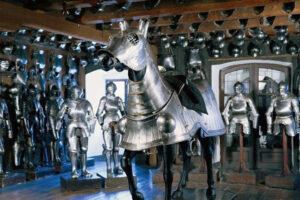
The Landeszeughaus, often known as the Styrian Arsenal, can be found right in the middle of the city of Graz. The building was constructed in 1644, and within it is a breathtaking collection of armaments and armor from the seventeenth century that have been completely preserved. In fact, the collection has sufficient equipment to arm 32,000 males, including helmets and weaponry.
In contrast, while you are in Graz you really must see the Landhaus. It was constructed in the Renaissance style between the years 1557 and 1565, and its primary facade is characterized by rounded windows and a veranda. In contrast to the magnificent stucco ceiling that dates back to 1746 that can be seen in the Knights’ Corridor, which is housed inside the lovely arcaded courtyard, the Renaissance fountain can be found in the Knights’ Corridor.
Find Out More About the Most Popular Tourist Attractions in and Around Graz, as well as Easy Day Trips
18. City Innsbruck and the Golden Roof are both Antiquated

The lovely city of Innsbruck in Austria is not only home to some of the most well-preserved old buildings in the country, but it is also home to some of the most unique and unusual historic structures. The Golden Roof, also known as the Goldenes Dachl, is one of the most well-known sights in all of Innsbruck.
This remnant from the prosperous Hapsburg past of the city is located in the center of Innsbruck’s Old Town (Altstadt), and it graces a Late Gothic oriel window of a former palace known as the Neuer Hof, which was employed by royalty. As you make your way down the arcaded Herzog-Friedrich-Strasse, you won’t want to miss this great area for taking selfies. If you catch it at the right moment (when the sun is out), the roof will give off the illusion that it is glowing.
The Golden Roof goes back to 1496, when it was erected to the building to honor the wedding of Holy Roman Emperor Maximilian I, and acted as a royal field so that the couple could enjoy the events taking place inside the square. The Golden Roof is comprised of a minimum of 2,657 gilded copper tiles. to pay tribute to the occasion. After you’ve taken some pictures, don’t forget to visit the Golden Roof Museum, which is where you can learn about the Emperor’s enduring legacy.
It is highly recommended that you take some time to explore the winding, narrow lanes and alleyways that surround this well-known site in Innsbruck. This lovely city in Austria is surrounded on all sides by beautiful mountains, and in addition to the many wonderful old buildings that can be seen here, visitors can also take in some breathtaking panoramas of the mountains that lie in their midst.
Herzog-Friedrich-Straße 15, 6020 Innsbruck is the address to send mail to.
Next Article England
